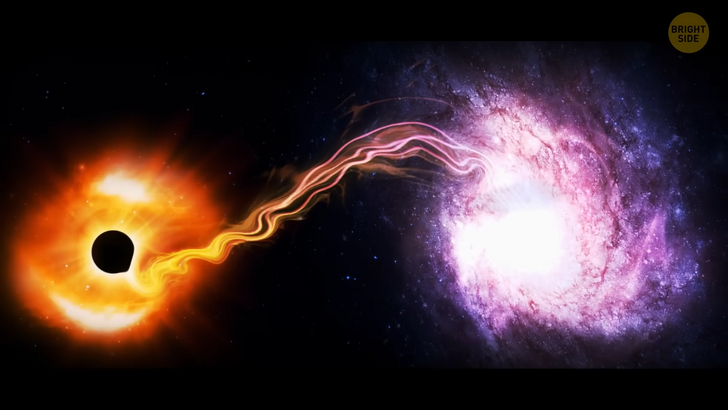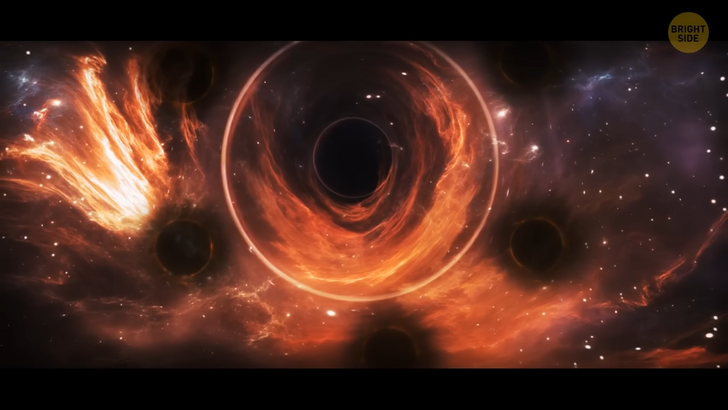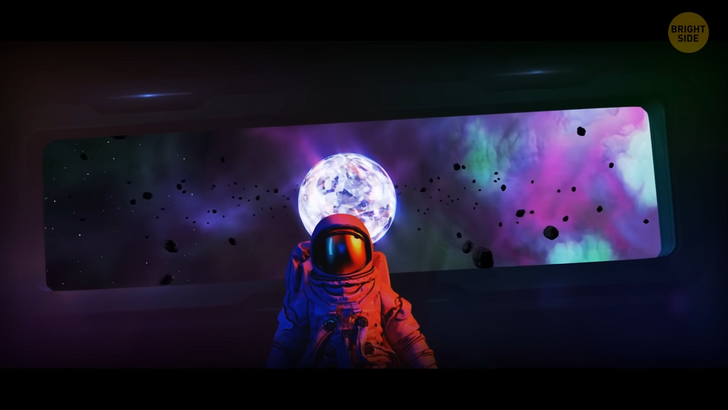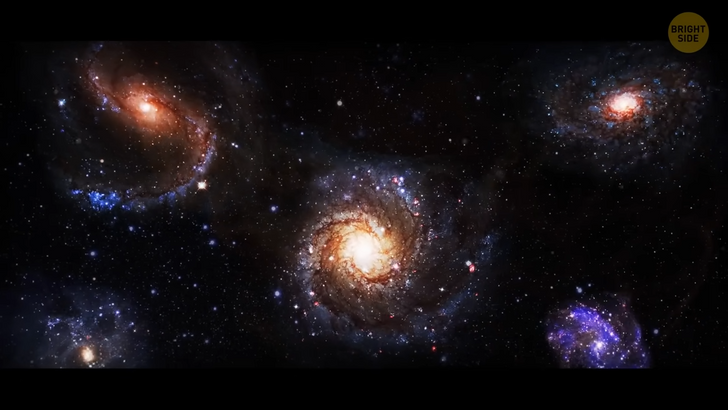My Wife Humiliated Me in Front of My Boss, I Can't Forgive Her

Fasten your seat belts! We’re setting course for the most bizarre places in our Universe — and you’ll see the most mysterious phenomena few people have ever seen before!
Recently, astronomers have discovered that the supermassive black hole at the center of our home Milky Way galaxy might be “leaking”! Why is it a significant change? Because it might mean that this black hole, called Sagittarius A*, whose mass is 4.1 million times the mass of our Sun, isn’t a sleeping giant as previously thought. It might still be active.

And the leakage recorded by scientists may be the hole “hiccupping” while swallowing clouds of gas! Hey I’ve been known to do that from time to time. During the research, the team of astronomers used the Hubble Space Telescope. It helped them spot a jet that looked like a blowtorch. It was pushing into clouds of hydrogen at the center of our galaxy. The jet seemed to “spew” gas like a hose directed into a pile of sand.
This often occurs around other active black holes surrounded by the material drawn to them by their immense gravitational pull. Some of this material gets pulled into the black hole. But a small part of it gets swept outward by powerful magnetic fields. The research suggests that when a giant gas cloud gets too close to our supermassive black hole, it gets swallowed. And then the hole “belches” small jets of matter.
Fermi bubbles might be the result of the “belches” that occurred around 2 to 4 million years ago. But recently, scientists have found another giant glowing bubble of hot gas. It aligned with the jet stretching for 35 light-years or more from the supermassive black hole. Astronomers suspect that the jet could have plowed into this bubble of gas and inflated it.

Now, let’s visit some other breathtaking places in our Universe! But be very careful — some of them are extremely dangerous! Like this rotating neutron star called the Black Widow Pulsar. Just like its spider namesake, it’s munching on its partner — a lightweight brown dwarf star. The more material this pulsar [J1311-3430] consumes, the more slowly it spins.
The energy the neutron star is losing in the process causes the companion star to dwindle. If it does exist, nuclear pasta is the strongest material in the entire Universe. Formed from the leftovers of extinguished stars, this substance gets squeezed into spaghetti-like tangles of material. It can break, but only if you apply 10 billion times the pressure needed to shatter steel.
How about visiting a planet where it rains glass? I’d rather not. This bright-blue exoplanet [HD 189733 b] looks peaceful and slightly familiar. Don’t you think it slightly resembles Earth? But this pretty appearance hides the planet’s terrifying nature. The winds blow at 5,400 miles per hour on its surface — it’s 7 times the speed of sound. But that’s not the worst: it rains glass — sideways — in this scorching hot alien world. Solar tsunamis are a solar phenomenon dubbed “terminator events.”

These tsunamis take place at the Sun’s equator. Disastrous magnetic-field collisions seem to cause ginormous twin tsunamis of plasma. These tsunamis tear across the star’s surface, moving at a speed of 1,000 feet per second. They can last for weeks at a time and happen every decade or so.
Look at this space body. Its nickname is “Electric Hyperion.” This Saturn’s moon is one of the most bizarre-looking moons in the Solar System. But its appearance isn’t the strangest thing about it. This pumice-stone-like rock pockmarked with countless craters is also charged with static electricity — and it’s flowing out into outer space!
Look at this — a rogue planet with auroras! Lost in space and drifting through galaxies, rogue planets were once flung away from their parent stars. But one of them, 200 light-years away from Earth, is different from the rest. It’s a planet-sized object with a magnetic field 200 times stronger than that of Jupiter. This field is so powerful that it generates flashing auroras in the planet’s atmosphere.
Stay away from black holes! Do I really need to warn you? Yep, they’re some of the most perilous objects in the Universe! But how about mini black holes? Unlike their massive siblings, hypothetical mini black holes could be really tiny — not bigger than an atom. Even so, just one minuscule thing would have the mass of a thousand sedans. One theory claims that tons of micro black holes could have been created right after the Big Bang and the beginning of the Universe. Some scientists even go as far as to say that a couple of mini black holes pass through our planet every day!

Ah, I bet you’ll like our next stop — a burning ice planet! Faraway Neptune-sized exoplanet Gliese 436 b is a paradox — it’s made of scorching hot ice! The planet completes one full orbit around the red dwarf Gliese 436 in just 2 days. It means it’s traveling remarkably close to its parent star. That might be the reason the planet’s temperatures rarely drop below 800˚F. But the strangest thing? The planet hosts huge volumes of water ice known as “Ice-x,” which remains solid despite blistering temperatures.
If you love jewelry, this next world is for you: a diamond planet! About 4,000 light-years away from Earth, there’s a planet that seems to be one enormous diamond. The planet is denser than any other discovered so far and consists mostly of carbon. It’s so dense that astronomers think this carbon might be crystalline. This, in turn, might mean that at least some part of the planet is diamond.
Moons orbiting other moons might exist, or they might not — astronomers haven’t agreed on this one yet. Planets orbit stars, and moons orbit planets. But then, why can’t there be moon-moons (also known as sub-moons, moon-ettes, and moooons)? It actually sounds like one of those flowery Hawaiian dresses — you know, Moo-Moos? But alas no. Researchers claim that moon-moons could exist. But the host moon has to be massive enough, the moon-moon — small enough, and there must be a wide gulf between these moons and the host planet.
Now, I’ll take you to the Living Fossil Galaxy. DGSAT I is as big as the Milky Way. But it’s nearly invisible because its stars are spread out incredibly thinly. But what makes the galaxy unique is that it’s sitting all alone, unlike other galaxies of this kind. Those are usually found in clusters. It can mean that DGSAT I was formed in a different era, probably a mere 1 billion years after the Big Bang. If it’s true, this galaxy is a real living fossil.

Now, you won’t be able to see the next space phenomenon. All because people can’t see infrared light. And the phenomenon I’m talking about is an infrared stream from space. Neutron stars are ultra-dense collapsed cores of giant stars. They usually emit X-rays or radio waves. But in 2018, astronomers discovered a weird stream of infrared light. It seemed to be coming from a neutron star 800 light-years away from our planet.
This signal was probably generated by a disc of dust surrounding the star. But this theory hasn’t been proven yet. Behind the orbit of Neptune lies the mysterious Kuiper Belt, filled with massive icy objects. The most curious thing about this space formation, though, is that scientists fail to explain the pattern of its movement. The only explanation they have is that Neptune might be hiding from our sight a ginormous planet. This hypothetical planet has already got the name Planet Nine, and all we have to do is wait until its existence is confirmed. Or not.
Let’s visit our star! But we need to be careful not to come too close. Because the Sun’s atmosphere is hotter than the surface of the star! While on the surface, the temperatures reach 10,000˚F, the upper atmosphere heats up to millions of degrees!

Scientists suspect that explosive bursts of heat from the Sun might have something to do with this unique phenomenon. This space object is also worth visiting! Haumea, a dwarf planet orbiting in the Kuiper Belt, has a bizarre, elongated shape and two moons.
The day on this planet lasts 4 hours, making it the fastest-spinning big object in our Solar System. But the most mysterious thing about Haumea is that the planet has a thin 40-mile-wide ring circling it. Ring a ding ding!











